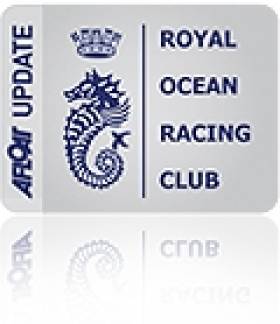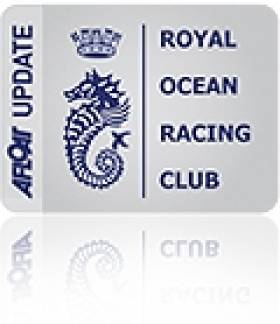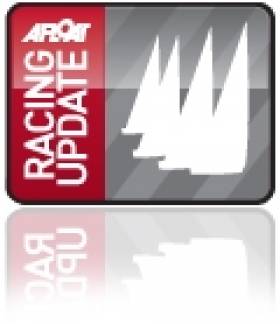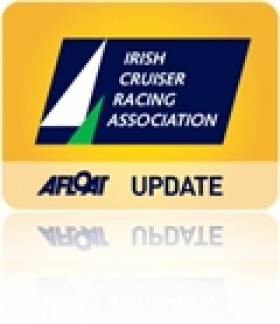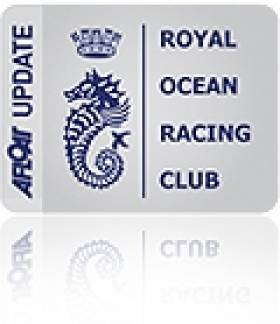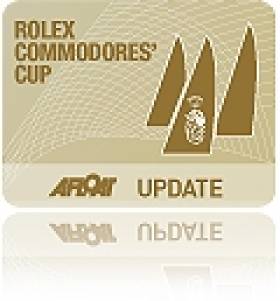Displaying items by tag: Commodores Cup
#rorcbdcc – Anticipation has been building going into this morning's start of the Royal Ocean Racing Club's biennial week-long Brewin Dolphin Commodores' Cup.
This year's event features nine teams, comprising four from France, one from Ireland and four from Britain (including one from Scotland), two more than 2012. Over the last few days crews from the three boat teams have been putting the finish touches to their campaigns. The thundery conditions of the last 48 hours have provided some lively moments for boats being delivered to Cowes, with one French boat experiencing 55 knot winds as she crossed the Channel.
As ever the RORC's flagship event for national teams with amateur crews comprises a challenging mix of inshore and offshore racing.
The event kicks off tomorrow (Sunday 20th July) with two inshore races, the first warning signal at 1055 BST. Over Monday-Tuesday the boats head off on an overnight offshore race, the longest of the regatta (set to last 24-36 hours) and carrying the highest points co-efficient of 2.5. Inshore racing resumes on Wednesday and Thursday followed by a race around the Isle of Wight on Friday, with a 1.5 co-efficient, the event concluding on Saturday with an inshore race carrying a co-efficient of 2. In past years the event has gone to the wire, with the final outcome only decided on the last race.
Competing yachts are rated using IRC, with boats having a Time Correction Co-efficient of 1.020-1.230. Among each three boat team, only one boat may have a TCC of 1.150-1.230.
Going into the event it is very hard to judge which team is favourite. "Who is going to win? No idea!" says RORC CEO Eddie Warden Owen. "The Irish are looking very strong with Antix having won the IRC Nationals. Marc Glimcher's Catapult has proven to be the strongest Ker 40 and Quokka won Cork Week last week with her Irish crew. I have to believe that they feel confident competitively. And the French are here with a purpose. They had one team two years ago and they said 'we want to win this event' and they have come back with four teams. We know some of their sailors but we don't know the quality of the boats - we'll find out tomorrow. We know they will be good, particularly offshore."
While the regatta is principally for amateur crew, each boat is allowed one ISAF Group 3 'professional' or two on the higher rated boats. Among the 'pros' are world class sailors including Laurent Pages, winner of the last Volvo Ocean Race board Franck Cammas' Groupama, Olympic sailors such as Peter O'Leary, leading sailmakers/sailors Kevin Sproul, Sam Richmond, Maurice 'Prof' O'Connell and Laurent Mahy, Olympic 49er/Volvo Ocean Race sailor Ian Budgen, and Figaro sailors Gerard Veniard and Nick Cherry.
"I think the most important thing when you talk to the competitors is how seriously they are taking this event," says Warden Owen. "The Brewin Dolphin Commodores' Cup is an important regatta to win, something that all the teams have put a huge amount of effort into."
Having good weather information is vital and all the teams are employing top meteorologists to help them - Chris Tibbs for Team GBR, Mike Broughton for the Irish, Christian Dumard for the French.
This week the tide isn't strong and the Azores high is edging across the UK, causing the winds to be light with little gradient pressure. So the RORC's new race management team led by former Etchells World Champion Stuart Childerley will be hoping for a sea breeze each day.
"The question is whether we will get northwesterly or northeasterly wind," says Dumard, a meteorologist and sailor of some 30 years standing, who was part of Corum's Admiral's Cup campaigns here during the 1980s and 1990s and prior to their winning campaign in 1991 spent one month surveying the Solent's winds and tides. Essentially the northwesterly is good for a sea breeze to develop, northeasterly less so, he says. "Tomorrow we should have a northwesterly wind in the morning filling in with the sea breeze from the southwest. I think tomorrow will be the best day for racing in the Solent."
According to Dumard the forecast shows adequate breeze for Monday's offshore race before the wind drops during Tuesday as an occluded front crosses the race course. Wednesday could prove the lightest day of the week, while on Thursday it will still be light, but a sea breeze is more likely to develop. "The race around the Isle of Wight on Friday is too far away to predict," he advises.
Stephen Ford, Executive Director of Brewin Dolphin commented: "Brewin Dolphin is thrilled to be back in Cowes this year, for our second regatta with RORC and the Brewin Dolphin Commodores' Cup. We are looking forward to an excellent week's racing with feisty competition from the French. We wish all the teams the very best of luck (especially the four GBR teams) and we have high hopes for a sunny and more importantly, breezy week.
"We and our clients are looking forward to an exciting weeks racing. With so many of our clients enjoying sailing, this is one of the highlights in our annual calendar and a week throughout which we will enjoy some highly competitive racing."
Ireland Names Her 31 Crew to Win The Commodore's Cup
#commodorescup – Ireland's team of 31 sailors are making final checks prior to the start of racing in the biennial Brewin Dolphin Commodores' Cup in Cowes, Isle Wight on Sunday morning.
Anthony O'Leary of the Royal Cork Yacht Club will again captain the Irish Cruiser Racing Association team of three boats on his own 'Antix' with the aim of winning the coveted trophy for the second time.
Marc Glimcher of the United States has provided 'Catapult' as the team second boat while Michael Boyd and Niall Dowling of the Royal Irish Yacht Club have chartered 'Quokka' for the week-long series.
All three boats were in action recently at Volvo Cork Week where crews had their final competitive practice before returning to Cowes.
The Commodores' Cup series will comprise six inshore races and a long offshore concluding on Saturday 26th July.
Crewlist for IRL 3939 Antix
Fred Cudmore - Ireland; Rosscoe Deasy - Ireland; Jamie Donegan - Ireland; David Lenz - United Kingdom; Ross McDonald - Ireland; Derek Moynan - Ireland; Darragh O' Connor - Ireland; Clive O Shea - Ireland; Robert O'Leary - Ireland; Anthony O'Leary - Ireland;
Crewlist for USA 1253 Catapult
David Bolton - Ireland; Grady Byus - United States; Alan Curran - Ireland; Garth Dennis - United States; Geoffrey Ewenson - United States; Marc Glimcher - United States; Tom Murphy - Ireland; Dan O'Grady - Ireland; Peter O'Leary - Ireland;
Crewlist for GBR 2215L Quokka 8
James Allan - United Kingdom; James Bendon - Ireland; Michael Boyd - Ireland; Laura Collister - United Kingdom; Ben Daly - United Kingdom; Niall Dowling - Ireland; Jarrod Hulett - United Kingdom; Tom Whitburn - United Kingdom; Nelson Moore - Ireland; Maurice O'Connell - Ireland; Nicholas O'Leary - Ireland;
Ireland Tipped As Commodore's Cup Favourites
#commodorescup – Having won the Commodores' Cup in 2010, Ireland was unable to mount a campaign to defend its title in 2012, but this year they are returning to Cowes for the RORC's biennial regatta for amateur national three boat teams, over 19th-26th July, with one of the strongest line-ups taking part writes James Boyd.
In recent years, while France and Britain have entered large numbers of boats into the Brewin Dolphin Commodores' Cup, Ireland's efforts have been notable for achieving top results but with a smaller but more powerful line-up. In 2006 they fielded three teams with Ireland Green coming home second to the French while, in 2008, Ireland was favourite going into the regatta but its two teams ended up second and third to GBR Red. Finally in 2010 it was third time lucky. The single Irish team dominated the regatta, finishing well ahead of Hong Kong and France.
This year's line-up continues this theme, with former Vice Commodore of the RORC Anthony O'Leary resuming his duties as Irish team leader and skipper of his Ker 39, Antix. The Irish 'big boat' is American Marc Glimcher's turbo charged Ker 40, Catapult, while making up the trio is a former IRC Nationals winner, Peter Rutter's Grand Soleil 43, Quokka 8, chartered for the occasion by Niall Dowling and present RORC Vice Commodore Michael Boyd.
According O'Leary, they started work on the campaign immediately after the 2012 Brewin Dolphin Commodores' Cup. His Olympic Star sailor son Peter was friends with American Olympic sailor Geoff Ewenson who serves as tactician on Catapult and between them they managed to persuade owner Marc Glimcher to bring the boat across from the USA for the season. Catapult has been in the UK since April and competed in the IRC Nationals, finishing third in IRC One behind Antix and Michael Bartholomew's GP42 Tokoloshe II.
Compared to the other Ker 40s, Catapult is lighter but with a deeper draft to retain her stability. As a result she has a higher IRC TCC of 1.210 compared to standard Ker 40s, such as the British team's Cutting Edge (1.195) and Hooligan VII (1.192). Given her higher performance, one imagines Catapult will benefit from being able to nose ahead of the other Ker 40s and into clear air.
To comply with the nationality requirements of the Brewin Dolphin Commodores' Cup, more than half of Catapult's crew will be Irish, with Ewenson and Peter O'Leary being the boat's two permitted 'pro' sailors, O'Leary still being classified ISAF Group 3 following his Star campaign for London 2012.
Antix herself has returned to her old form, winning this year's IRC National Championship. According to her owner, part of the reason for this is due to them returning the boat to her successful 2010 configuration. "After 2010 we lightened the boat overall and the bulb, but it didn't turn out to be that successful. Fortunately we hadn't disposed of the original bulb and we put it back, which was an easy change."
This time the O'Leary trio of sons is evenly distributed across the Irish fleet with Robert on Antix, Peter on Catapult and Nicolas on Quokka 8. As O'Leary puts it: "I think four of us on the same boat could lead to some family disputes and what have you, so it was best to spread the load around the place!"
The pros on Antix and Quokka 8 are North Sails' Dave Lenz and Maurice 'Prof' O'Connell respectively, both of whom competed in 2010 (O'Connell then sailing on Roxy) while on Quokka 8 Michael Boyd will be navigating and Niall Dowling helming. Roughly half of the Antix crew competed in O'Leary 2010 winning crew.
Interestingly while Anthony O'Leary is an old Brewin Dolphin Commodores' Cup hand, both the Catapult and Quokka crews are first timers. As O'Leary puts it: "The Americans haven't done it before, so they are fascinated with the team concept and the general layout of the regatta."
Meanwhile Quokka was late returning from her regatta program in the Caribbean and O'Leary was impressed that to fill the gap, Niall Dowling and Michael Boyd chartered other boats to help get their crew race ready. "That has taken a lot of effort and focus," he says.
Generally O'Leary feels confident of his team's prospects against the sizable GBR competition, which they regularly sail against. However the French are an unknown quantity, with the exception of Antix's sistership, the Gouy family's Inis Mor, which he says is particularly strong offshore. "If we arrive with our A-game we'll be confident of a decent result."
As to why O'Leary is spearheading another campaign for the Brewin Dolphin Commodores' Cup, he explains that the attraction is: "An event of that duration with so many races, and such a variety of races, without a discard - it is full on. The intensity of it is great, it is just what you want to sail. It is the highlight of our programme every two years."
#commodorescup – With the entry list now closed, nine teams have confirmed their participation in the Commodores' Cup, taking place out of Cowes over Saturday 19th July until Saturday 26th July.
This year the Royal Ocean Racing Club's biennial flagship event for national teams with amateur crews has two more teams than when the event was last held in 2012. This is thanks to France and Great Britain both fielding four teams, each comprising three boats.
The teams feature many previous Brewin Dolphin Commodores' Cup participants, particularly in the French line-up, where they are keen to emulate the success of the campaign led by Géry Trentesaux in 2006.
"The French have come back with vengeance - they have got severe strength and depth, which is going to be an interesting problem for everyone else," advises CEO of the RORC, Eddie Warden Owen. "They are taking it seriously. The crews are all friends and I think they will be a severe handful for the rest of the teams."
Ireland, winner in 2010, was unable to defend its title in 2012, but is back with a team every bit as strong as it was four years ago. While it doesn't have the same depth as the British and French, the one Irish team is of exceptionally high quality. As in 2010, the effort from the Emerald Isle is being spearheaded by Anthony O'Leary, once again campaigning his Ker 39, Antix, the recent winner of the IRC National Championship. O'Leary, a former Vice Commodore of the RORC, will be joined on the Irish Team by the current Vice Commodore, Michael Boyd, competing on Quokka 8.
"The Irish are sailing very well," says Warden Owen. "I think Antix has done a brilliant job. The other two boats have put a lot of time in, so I see the Irish as being strong."
However the French and the Irish will be up against the defending champions, Great Britain, this year comprised of three teams from the nation as a whole and one specifically from Scotland.
Surprisingly there are few surviving members of the 2012 winning GBR Red team among the British crews. One is sailmaker Kevin Sproul, who is racing as one of the two ISAF Group 3 'pros' aboard James McGarry's Swan 45, Eala of Rhu. For Sproul this year's event will be special because he has sailed the Brewin Dolphin Commodores' Cup twice before and twice has won, on both occasions sailing with Jonathan Goring. If Team Scotland is successful, then this year will be his hat trick.
However this will not be easy, Sproul recognises: "The Brewin Dolphin Commodores' Cup is a team event and a lot of people underestimate that. The reason we won it last time with GBR Red is that we had a good all round team, and all three boats got the results they needed. It was the same the previous time we won it. I think it will be a tough event - It always is."
In last weekend's Round the Island Race, Team Scotland's highest rated boat, Eala of Rhu, proved her potential, leading the giant fleet through the Needles and very nearly getting monohull line honours. "It was all about avoiding the holes," Sproul continues. "But the bottom line is - in light winds the boat is very competitive and it has already been quite good when it is breezy. Plus they have got a good squad on that boat and they sail it well."
Meanwhile, Rod Stuart's Corby 37, Aurora, has won her class at Cowes Week for the last two years and Steve Cowie's First 40, Zephyr, is newer to her crew, but all are solid sailors, advises Sproul.
Apart from his own team's prospects, Sproul rates the Irish. "They have got good boats, obviously the Ker 40 which we know is capable of finishing top boat," he says, referring to the Irish team's Catapult. Two years ago Sproul sailed as tactician on board Jonathan Goring's Ker 40, Keronimo. "Then they have Antix, which is a weapon of a boat in terms of her rating. She is a very competitive boat that they've sailed well for a long time. And Quokka has proved to be competitive in the past as well."
Sproul also observes that the Irish team features three boats with comparatively higher ratings compared to the fleet overall, enabling them a better chance to race in clear air.
Otherwise Sproul is looking forward to the regatta: "I like the fact that it is a team event, with very different racing every day and the whole concept of Round the Isle of Wight and the offshore race is good. It gives different types of boats the chance to shine. That is why it always goes to the wire. You can't go out and say 'we've got a good boat - we're going to win this', because it doesn't matter how good your individual boat is - if you're not good as a team then you'll never win."
The Brewin Dolphin Commodores' Cup 2014 will be held between 19-26 July 2014 at Cowes, Isle of Wight.
2014 BREWIN DOLPHIN COMMODORES' CUP
Nine teams from three nations
TEAM GBR (4)
GBR Red
Iain Kirkpatrick; X 37 - Fatjax
Seb Blair; King 40 - Cobra
Robert Lutener and Martin Elwood; Ker 40 - Cutting Edge on Baraka
GBR White
James Gair; Mills 39 - Localletterbox Zero II
James Neville; Corby 36 - INO
Ed Broadway; Ker 40 - Hooligan VII
GBR Blue
David Aisher; J/109 - Yeoman of Wight
Robert Stiles; J/109 - Diamond Jem
Richard Patrick; First 40 - Dusty P
Scotland
Jamie McGarry; Swan 45 - Eala of Rhu
Rod Stuart and Bill Ram; Corby 37 - Aurora
Steve Cowie; First 40 - Zephyr
FRANCE (4)
France Red
Hervé Borgoltz; Grand Soleil 44R - Eleuthera
Olivier Pesci; Grand Soleil 40 - Beelzebuth
Emmanuel Le Men; First 40.7 - Pen Koent
France White
François Lognoné;J/122 - Nutmeg IV
Philippe Baetz; Grand Soleil 37 - MUSIX
Benoit D'Halluin;A35 - Dunkerque Plaisance
France Blue
Bernard Gouy; Ker 39 - Inis Mor
Jean-Claude Nicoleau; Grand Soleil 43 - Codiam
Gilles and Samuel Prietz; A40RC - Goa
France Green
Eric De Turckheim; A13 - Teasing Machine
Gilles Caminade; A35R - Chenapan 3
Eric Basset; Farr 30 - Motive
IRELAND (1)
Anthony O'Leary; Ker 39 - Antix
Marc Glimcher; Ker 40 - Catapult
Michael Boyd and Niall Dowling; Grand Soleil 43 - Quokka 8
RYA Announces Four Teams for Commodore's Cup
#rya - The RYA has announced that following the conclusion of its selection trials over the bank holiday weekend (24-26 May), four teams have been selected to represent RYA Team GBR at the Brewin Dolphin Commodores' Cup 2014 in July, where Great Britain will aim to defend its 2012 title.
With RYA Team Scotland already announced in February, the RYA retained the potential to select up to three further teams. The remaining boats within the trials have looked to impress the RYA Selection Panel of Chris Mason, Chris Arscott and Jonathan Goring who have been on the water observing the boats and their crew work over a series of inshore and offshore events.
The selection trials started on 3 May with the RORC Cervantes Trophy across to Le Havre. The race turned out to be a very light wind race which favoured the smaller boats as the wind increased towards the end of the race.
Due to the cancellation of the Vice Admiral's Cup, which was due to be run between 9-11 May, to provide the inshore section of the trials, the remainder of the trials had to be re-organised swiftly to ensure that selections could be based on good, solid racing. This included organising a re-run version of the Vice Admiral's Cup and a specific offshore race run for the RYA by RORC, which were all squeezed into the bank holiday weekend.
Chris Mason, Chair of RYA Selection Panel, commented: "The RYA would very much like to thank Jo Chugg and her team at the Royal Corinthian Yacht Club in Cowes and Nick Elliott and his team at RORC for helping the RYA rearrange its trials at such short notice. I would also like to thank Stuart Childerley as Race Officer for the weekend and importantly all of the owners and crews for being so patient and forgiving in assisting the RYA in looking at alternative dates and formats of racing.
"In the end it turned out to be a great weekend's worth of racing that challenged the teams and gave us as selectors a good indication of form to pick the best combination of teams to sail to retain the Brewin Dolphin Commodores' Cup. The conditions, whilst damp on Saturday, offered up a wide variety of conditions and it was good to pick up on where certain teams performed well and where others didn't."
Based on the results and performances across the trials, the following teams have been selected to represent RYA Team GBR at the Brewin Dolphin Commodores' Cup 2014;
RYA Team GBR Red
Iain Kirkpatrick; X 37 - Fatjax
Mike Blair; King 40 - Cobra
Robert Lutener; Ker 40 - Cutting Edge on Baraka
RYA Team GBR White
James Gair; Mills 39 - Localletterbox Zero II
James Neville; Corby 36 - INO
Ed Broadway; Ker 40 - Hooligan VII
RYA Team GBR Blue
David Aisher; J109 - Yeoman of Wight
Robert Stiles; J109 - Diamond Jem
Richard Patrick; Beneteau First 40 - Dusty P
RYA Team Scotland
Jamie McGarry; Swan 45 - Eala of Rhu
Rod Stuart; Corby 37 - Eos
Steve Cowie; Beneteau First 40 - Zephyr
Mason concluded: "It has proved to be a challenging series and we wish all of the competitors the best of luck in the Brewin Dolphin Commodores' Cup."
Nigel King, RYA Racing Keelboat Manager and RYA Team GBR Team Manager, added: "It's great news that the selectors were able to pick four teams for the 2014 event. There is no other event like the Brewin Dolphin Commodores' Cup on the calendar and I am very excited to have the chance to work with the British teams again. Now everyone can really start planning the defence of our title and I am really looking forward to working with the sailors as we try to achieve this goal."
The Brewin Dolphin Commodores' Cup 2014 will be held between 19-26 July 2014 at Cowes, Isle of Wight.
O'Leary to Captain Potent Irish Commodore's Cup Team
#commdorescup – Although Ireland will be setting sail for Cowes as a potent Commodore's Cup force this July it will only be a single team as a second 'corinthian' team could not be mustered. At the Spring meeting of the ICRA executive, Commodore's Cup team manager Barry Rose made a detailed report on preparations. The meeting heard the team will sail without the support of sponsorship, in spite of major effort by the Irish Cruiser Racing Association (ICRA) to secure a team sponsor none had been found.
Anthony O'Leary has been confirmed as team captain, a position he also held in the 2010 Commodores' Cup winning Irish team.
As has been widely reported the three boat Irish team consists of Catapult, a US based Ker 40 which had been shipped to the Solent and was due to be enter the water to start her training programme on the 1st May.
Quokka, a Grand Soleil 43, had been chartered by Royal Irish sailors Michael Boyd and Niall Dowling. O'Leary's Antix, a Ker 39, completed the line-up.
The services of meteorologist Mike Broughton had again been secured on an exclusive basis to provide local tactical and Solent tidal support to the team.
#irishsailing – After five years of economic contraction, there are signs of recovery, and the 2014 Irish sailing season has also got off to a flying start. W M Nixon looks at various signs of new energy and initiatives, and sees how they might be affecting stories which have been run on this blog and in the Afloat.ie website during the past year. But he concedes that further cost reductions will be necessary for the good of the sport.
A year ago, any talk of green shoots in Ireland was almost entirely metaphorical. And it was in the economic sphere, though even there they were still few and far between, with many soon stunted. But out in the farmers' fields themselves, out where the grass should have been growing, there was scarcely a sign of life as we were still trapped in the coldest and most miserable Spring in living memory, and all forms of growth and recovery were blighted by it.
Sailing and boating, of all sports, are the most affected by Ireland's climatic conditions. Not only is the mood among participants strongly influenced by weather which sometimes can get anyone down, but without reasonable breezes, sailing events are seriously impaired. "We got a result!" may well be the PRO's final desperate claim after pulling some sort of a points table and leaderboard out of a series bedevilled either by too much or too little wind. But it's so much better to have a series bathed in sunshine and blessed by fine breezes, with enough races sailed for the crews to go home tired but happy without needing recourse to any of those weasel words which show you're only trying to justify a weekend of frustration.
Things could not be more different this year. The Spring of 2014 has been perfection, boats are going afloat on time and in reasonable weather conditions, and the first little crop of events and results are very encouraging indeed - so encouraging, in fact, that "little crop" doesn't do them justice.
That said, two of the nearer events which gave special cause for Irish celebration did not have perfect weather throughout. The Youth Sailing Nationals at Howth may have ended on a high with a great breeze in an early taste of summer sunshine, but one day out of the four was lost to bad weather. But the sting of that was lessened by the decision for "no racing all day" being taken at 1100hrs, which allows other leisure options to kick in.
The IRC Easter Championship in the Solent concluded through Easter Monday literally with "Darkness at Noon" – the heavy clouds and torrential rain on an almost windless day saw the final races being sailed with nav lights on. But there had been excellent racing on earlier days, and a very excellent result with Anthony O'Leary's Ker 39 Antix from Cork the clear supreme champion.
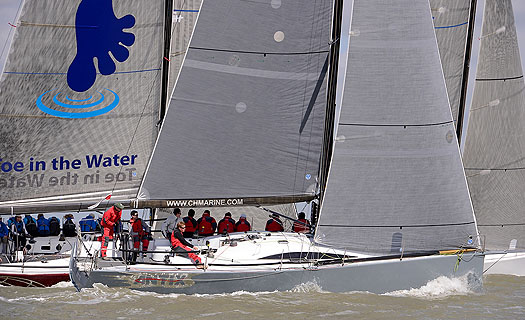
Doing the business. Anthony O'Leary's Ker 39 Antix settling into the groove on the way to the top place in the Easter IRC Championship. Photo: Rick Tomlinson
That in turn augured well for Ireland's Commodore's Cup chances, which then received a further boost last weekend when the crew of another Irish team wannabe, Quokka with Michael Boyd and Niall Dowling, had a winning weekend in the Warsash series with their temporary mount Tarka in anticipation of Quokka's return from the Caribbean at the end of May.

The Colours Match team racing between UCD and Trinity served up top sport in the Liffey, with Trinity winning. Photo: W M Nixon
Meanwhile the universities racing has been brought to life, for although UCD had a convincing win in the racing with the SailFleet J/80s to become the Irish team for the Student Yachting Worlds in France in the Autumn, before April was out the Colours Match in the Liffey under the burgee of the Royal Alfed YC, team-raced in Fireflies, saw Trinity take the honours in convincing style.
But if we're looking for something which really did set things freshly alight, it was out in Hyeres where the ISAF Championship saw the northern duo of Ryan Seaton & Matt McGovern take silver in the 49er, almost immediately moving them up the global rankings from 33 to 11, a quantum leap and no mistake.
The potential for serious success by these two has been fairly obvious for some time, but anyone who sails boats will know only too well how many factors have to come into alignment to get you up among the magic metals at the end of the day.

Stars of the silver sea – the Seaton/McGovern team took a silver medal for Ireland at Hyeres.
That their new global status was almost immediately acknowledged by this rankings improvement will in turn add heft to everything they do and say. Thus when, some time ago, the Ryan/Seaton equipe suggested that the 2016 Olympics sailing waters in Brazil are so off the standard as to be a health hazard, it attracted polite attention. But now that they're Number 11, and still counting down, much more notice is taken. And the fact that the Vice President of the International Olympic Committee has suggested, with something approaching despair, that the facilities in Brazil just aren't going to be ready for 2016 at any standard, all gives added legs to the statement from Ireland's 49er crew.
This in turn makes us wonder where world sailing might go in 2016 if the Brazilian setup is still Work in Progress. With tongue only slightly in cheek, we suggest they need look no further than West Cork, where Baltimore Sailing Club has been expanding its facilities to meet increased demand as a club which last year introduced something like 700 people to sailing. That BSC and current Mitsubishi Motors "Club of the Year" Kinsale YC further east along the West Cork coast have both been putting in premises up-grade during the past year, while other clubs have been having it tough, and just about hanging in there in some cases, surely gives pause for thought.
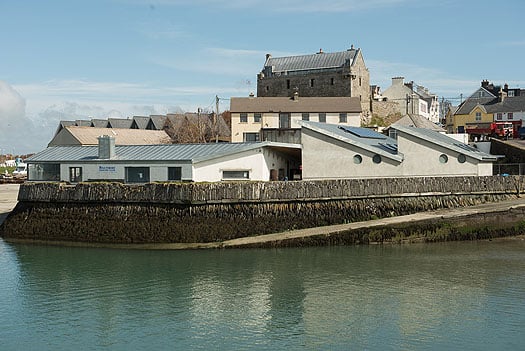
Olympic venue? The extended and up-graded Baltimore Sailing Club is ready and raring to go.
The economic shakeout of the past five years has caused a massive write-down in the value of almost all property and other assets. And in the case of yacht and sailing clubs, there has been a detailed examination of the continuing validity, or otherwise, of established yacht clubs and their traditional business model of quite high subscriptions under-writing other facilities which in turn combine to provide the complete package of an orthodox yacht club.
Inevitably, most clubs are run by officers and committee members who have been involved with the club for many years. Thus, like people who have been running a quality hotel for decades, they may have an inflated notion of what their organisation and its premises are actually worth. Admittedly there's only limited usefulness in comparing a yacht club with a hotel, but lessons can surely be learned. The fact is that hotels today are worth maybe only a third or even less of what they were reckoned to be worth six years ago. And equally, while yachts clubs certainly have a unique package to offer, is it unusual enough and special enough to charge high subscriptions when there are alternative facilities and services available?
The dilemma arises to some extent in all sailing centres. Last week we were discussing the story of the development of Howth YC. Today it is in the seemingly happy situation of having its own marina, thus it theoretically can offer an attractive all-in-one package to any potential member. But the very fact that Howth YC has done so much to help make Howth a colourful and vibrant sailing/fishing port is partly to its own disadvantage. The place has developed as a remarkable focus for top seafood restaurants. This means that the extensive club catering facilities – expected by traditional members - are constantly battling for business with a whole slew of award-winning eateries and characterful pubs nearby.
The problem is more acute in Dun Laoghaire in that the only club within the marina area is the Royal Irish YC. Thus while people may have been loyal members of the National, the Royal St George and the Dun Laoghaire Motor Yacht Club, they find that after going out in the boat, it's very easy to round out the evening aboard in the marina, chatting among themselves or with other crews on boats nearby, and then head straight for home without making their number in their home clubs at all.
This situation is less in evidence at weekends and during special events. But nevertheless it was causing such a lessening in mid-week club vitality that various steps have been taken, and the Royal St George's move to take over berths in a block booking in the outer marina, and service them by a frequent ferry direct from the clubhouse, is a visionary step.
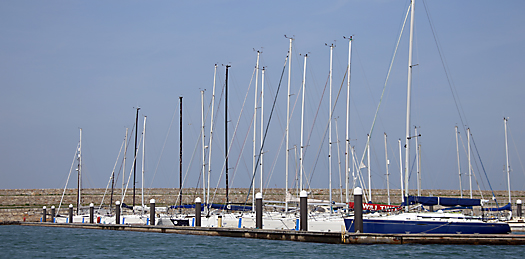
The Royal St George YC has introduced a direct ferry service from the clubhouse to its group of berths in the outer marina in Dun Laoghaire. Photo: David O'Brien
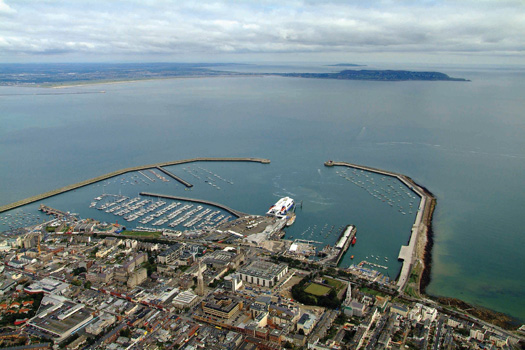
To overcome a lack of direct access to the Dun Laoghaire Marina, the Royal St George YC is running a ferry service from its clubhouse (to right of Stena Ferry, foreground) to the berths in the Outer Marina (upper left) Photo Kevin Dwyer/courtesy ICC.
Nevertheless, in all club administrations there are those who are of the opinion that, whatever the Honorary Treasurers may believe, there has to be a radical re-think of the primary subscription levels. In essence, they're suggesting that the book value of the club has to be written down such that subscriptions are halved. Personally, I haven't much of a notion of how to read a balance sheet, but the dogs in the street know that in the hospitality industry – which, in the broadest sense, is the area in which yacht and sailing clubs operate – values have been savagely slashed, and while charges may still seem high, at least the places are surviving as going concerns.
With continuing reduction in expenses across the board, one area in which there seems to be much work afoot is in the Irish Sailing Association, which in latter days had begun to seem like some hidden corner of the civil service, existing more for the benefit of staff than for the provision of services for sailors. It's amazing to learn that the ISA has sixteen fulltime staff, and a basic annual wages bill of something like €600,000. When you add in the expected benefits, it musty come in total to a very tidy yearly sum.
What on earth do they all do? While you'll invariably find the ISA logo in prominence at some top events, it has to be said that you're entirely unaware of the organisation's existence in any form at more everyday happenings, and it doesn't seem to be because they believe in doing good work by stealth. But with special study groups resulting from the major changes introduced in the ISA setup at the AGM in March, we can only hope that in time the Association will reflect the cost-cutting which has had to be introduced in the clubs, which provide the main part of the ISA's income.
While the administrative structures are rightfully being pared back in many areas of our sport, the coastal infrastructure, on which all forms of seagoing ultimately depend, continues to need maintenance and development. In this area, one very promising green shoot is the news that there are signs of movement in Dunmore East. A dredging programme is getting under way, and just this Tuesday, Minister for Marine Simon Coveney TD convened a meeting in the port to inaugurate a community approach to harbour development which, it is hoped, will help to invigorate the many places around Waterford Estuary, for which Dunmore East has the potential to be the true gateway harbour.

Dunmore East – can it fulfil its potential as the gateway leisure port for the Waterford Estuary? Photo Kevin Dwyer, courtesy ICC
In a more extreme marine environment, it has been confirmed that €6 million will be spent on improving the pier at Doolin in northwest Clare, the nearest mainland quay to the Aran Islands, which also caters for the tour boats cruising along the Cliffs of Moher. While the locals seem well pleased, I wouldn't get too excited about it. This is one very rugged part of the coast, and when you remember that it took €31 million to extend the pier at Kilronan in Inismor, the main Aran island, and another €14 million to build the little harbour at the north end of Inis Meain, the middle Aran island, then we can only hope that €6 million is going to achieve something more than a few boulders being shifted about in the roaring ocean at Doolin.

The pier at Doolin is decidedly minimalist, but it provides the shortest sea passage to the Aran Islands. Photo: W M Nixon
But then, in the west all things are possible, and along the ocean seaboard we're told that four thousand signs are being erected to guide people along the Wild Atlantic Way, the new tourism initiative using many smaller coastal roads. Quite so. Frankly, with signage at this level, it will be the Tame Atlantic Way by the time half of them are in place. I have to admit to being a complete curmudgeon in this. In many years of transitting Ireland's west coast by sea and land, one of our favourite areas while driving along the west coast has long been the coast south of Kilkee down to Loop Head, where the cliffs comfortably rival anything the vulgar Cliffs of Moher have to offer, and it is magnificently uncrowded. But not any more, if the Wild Atlantic Way movement has its way.
While I appreciate that visitor numbers have to be kept up and increased whenever and however, it has to be done in a way which appreciates that's what brings people to Ireland (rather than just to Dublin, which is a special case) is an unspoilt landscape. So, four thousand signs just for the one Atlantic Way? Ogden Nash had something to say about this:
"I think that I shall never see,
A billboard lovely as a tree.
But then, until the billboards fall,
I'll never see a tree at all".
Be that as it may, the final sign that suggests things are on the move again is a notice I spotted recently posted at a nearby club, though language pedants might wonder how a notice which manages to mangle so utterly the plural of "dinghy", even to adding a completely superfluous greengrocer's apostrophe, could be seen as encouraging in any way whatsoever.
Well, once you've overcome your opinions about the errors, the underlying message must be good news. More youngsters are evidently coming to sailing this year. And as for the spelling mistake, even that's an improvement. A year ago, the same notice board opened by referring to something called "a dingy", but this time round we have to get to the second line before finding that. And it all comes right for dinghies in the end.
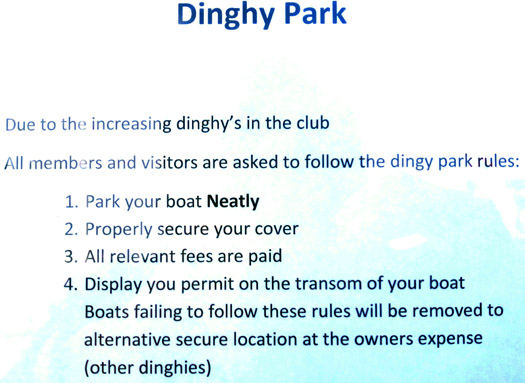
Sign of the times? Whatever about the spelling, this current notice at an Irish sailing club has an underlying message of good news. Photo: W M Nixon
#icra – One of the first complete Scottish teams has emerged as the first GBR entry for the 2014 Brewin Dolphin Commodores Cup hosted by The Royal Ocean Racing Club (RORC) at Cowes this July. Ireland, who won the Cup in 2010, have also entered a team under the ICRA flag.
The Clyde based team consists of a group of committed owners who have been working throughout the winter in creating a team with a broad experience, that includes some of the leading professionals in recent event history.
Eala of Rhu, owned by Jamie McGarry and Colin Moore of the Royal Northern & Clyde have recruited Kevin Sproul, who sailed Keronimo to victory for GBR Red in the 2012 event. He joins Jon Fitzgerald in running the Swan 45 in the international IRC Regatta.
The First 40, Zephyr from Royal Gourock YC has competed successfully over the past couple of seasons with owner Steve Cowie, both in Ireland in 2013 and winning their Class at Cowes in 2012. The choice of pro is natural one as Ian Budgen started sailing at RGYC in Pipers before building a strong reputation in the sailing world from the TP52 circuit, the Volvo Ocean Race and the Americas Cup.
Completing the three-boat team is the Corby 37, fomerly Impetuous, a competitive IRC boat which is new to the Clyde Cruising Club owners Rod Stuart, Bill Ram and Donald MacKenzie. Rod Stuart who competed with EOS, an Elan 410, has enjoyed some good offshore results including 2nd in class in the 2013 Middle Sea Race. Sailmaker and experienced IRC campaigner John Highcock takes on the professional role onboard.
Peter O'Leary Video – Commodore's Cup Plans & Star Sailing
#Qkeywest – Olympic helmsman Peter O'Leary confirms this Summer's Irish Commodore's Cup team will largely be comprised of the crews that won it in 2010. Speaking dockside after finishing third overall at Key West, Florida yesterday, the 2008 and 2012 Star Olympian for Ireland and crew member aboard Catapult, talks about having skipper Marc Glimcher and his Ker 40 join the Irish team for the Commodore's Cup this July.
O'Leary was in Key West this week with Howth's Dan O'Grady, a 1996 Olympian and David Bolton, part of the 2010 Commodore's up winning crew. The aim for O'Leary was to work up a new crew this winter for a bid at a second Irish Commodore's Cup victory.
O'Leary will be competing at the UK IRC championships on board Catapult instead of sailing his Star since the class was ditched for the 2016 Olympic regatta. Although O'Leary says it now looks too late for the reintroduction of the class, the latest plea by the Brazilian government to reinsert the class may change all that.
The American 40 footer will be joined by O'Leary's family boat, Antix, a Ker 39 (crewed by father Anthony and its regular Cork crew) and as previously reported, a UK based Grand Soleil is expected to complete the three boat Irish team.
Final Day Drama and Very Happy Sailors at Quantum Key West 2014
There was plenty of final day drama at Quantum Key West 2014 as the winners of several classes were determined during the last race. And conditions could not have been better for those winner-take-all scenarios with the southernmost point of the United States delivering the strongest winds of the regatta.
North-northeasterly breezes in the 18-24 knot range made for some spectacular racing on all three courses and enabled all 10 classes to complete 10 races for the five-day event.
No class was more closely watched all week than IRC 2, which featured six 52-footers crewed by a who's who of the professional ranks. Quantum Racing, skippered by Amway president Doug DeVos of Ida, Mich., began the day with a three-point lead and did what was necessary to secure the 52 Class championship by placing third in Race 10.
"What a great week!" DeVos exclaimed upon returning to the dock following Friday's lone race. "Great competition, great weather, great race management and great sailing conditions. This is really a fabulous event from top to bottom."
America's Cup veterans Terry Hutchinson and Ed Baird served as tactician and strategist, respectively, aboard Quantum, which wound up winning five of the 10 races. Juan Vila was aboard as navigator for entry fielded by the sailmaking company that is title sponsor of the event.
Ran Racing, the British entry skippered by Skype founder Niklas Zennstrom, finished second in the final race, but wound up two points behind Quantum for the regatta. Ran, the reigning TP 52 World Champion, won two races and placed second or third in six others to finish 5 ½ points ahead of the Italian entry Azzurra, which captured class honors at Quantum Key West 2013.
"It was a fantastic week of sailing and we are very pleased with the regatta in terms of how the team and boat performed," Zennstrom said. "It's a good start to the season, a good start to the series."
Ran and Quantum held first and second for most of Race 10, but Azzurra sailed a great last leg and skipped past both to get the gun. Vasco Vascotto (tactician), Francesco Bruni (strategist) and Guillermo Parada (helmsman) comprised the afterguard aboard Azzurra, which earned the Quantum Sails Boat of the Day award.
An anticipated duel between the top two boats in Melges 32 class never materialized as skipper Dalton DeVos and the Delta team had an on-course-side start and were never able to challenge owner-drive Alec Cutler and the Hedgehog crew.
"We wanted to get a great start and pushed the line. Unfortunately, we were just a tad early and had to turn around," DeVos said. "Hey, that's sailboat racing. They don't let you get a head start."
Multi-time Canadian Olympian Richard Clarke called tactics for Cutler, who got a great start and led around every mark in winning by more than a minute. Two-time Olympic gold medalist Jonathan McKee was tactician on Delta, which battled back to take second and actually tied Hedgehog with 15 total points. Both boats won four races, but the Bermuda entry won the tiebreaker based on the result of Race 10.
"We knew we had to go out and win the race. That was the only option," Cutler said. "The committee boat was favored and we won that end of the line. We then put the hammer down and just sailed as fast as we could."
Cutler, a former intercollegiate sailor at the Naval Academy, has competed in Key West five times and been runner-up twice in Melges 24 class. This was his first victory in the annual midwinter regatta off the Conch Republic. "Our entire crew worked really well together and our boat-handling was outstanding the whole week," he said.
Organizers with Premiere Racing deemed the most impressive performance of the regatta was put forth by skipper Tim Healy and his team on Helly Hansen, which won the 60-boat J/70 class in convincing fashion. Healy, a professional with North Sails, repeated as class champ in Key West by winning two races and placing second or third in five others.
Helly Hansen clinched the regatta by finishing third in Race 9 and therefore did not sail the final race, using that as its throw-out. Geoff Becker and John Mollicone combined on tactics and trimming while Gordon Borges worked the bow for Healy, who is also a standout J/24 sailor.
"Obviously the biggest key to success is having a good team. My guys did an awesome job of boat-handling and tactics," Healy said. "We sailed here last year so we had a real good feel for the race course. This team has also sailed J/24s together the past few years so we have a comfort level that makes a big difference."
Healy and Helly Hansen came away with the biggest prize - capturing Quantum Sails Boat of the Week honors. "We had a huge class down here last year with a lot of really good sailors so it's a great accomplishment to come out on top. Winning Key West is definitely one of the highlights of my career," said Healy, a 42-year-old resident of Jamestown, R.I. Eight different boats took first place during the week.
Hot Mess, skippered by Rob Britts of St. Petersburg, Fla., was crowned as Corinthian champion of J/70 class. Britts posted six wins and three seconds within the 14-boat sub-class comprised of all-amateur crews.
Four boats entered the final day of action with a mathematical chance to win IRC 3 class, comprised of a diverse group of designs. Arethusa, a Swan 42 owned by Phil Lotz of Fort Lauderdale, finished fourth in Race 10 to hold the lead for a third straight day. Former Olympic medalist Jeff Madrigali served as tactician aboard Arethusa, which placed seventh out of 10 boats in Race 1, but never finished lower than fourth the rest of the way. Just eight points separated the top three boats in IRC 3 with the Ker 46 Tonnerre de Breskens (Peter Vroon, The Netherlands) the runner-up by five points.
"We are very excited about winning our class at such a prestigious regatta," said Lotz, who had placed at Key West a couple times before. "Our boat was very good in the medium breeze that predominated this week. We tried to start cleanly and had a fairly conservative game-plan. Jeff was outstanding tactically all week and did a good job of keeping us in phase."
PHRF 1 was also up for grabs going into the last race and Spaceman Spiff, the J/111 owned by Rob Ruhlman of Cleveland, Ohio, seized the moment by winning. This was the 13th trip to Key West and the first class victory for the Spaceman Spiff program.
"We've been trying to win this regatta for a while and it feels good to finally break through. It feels even better because of the quality of competition we faced. This is some of the closest PHRF racing in which I've ever participated," said Ruhlman, who had his wife and son aboard. "We really had a blast this week. It was great sailing and all the people in the class are so friendly. We passed Teamwork on the way into the harbor and their entire crew applauded us."
Teamwork, a J/122 skippered by Robin Team of Lexington, N.C., came up short in its bid to three-peat in Key West - finishing 4 ½ points behind Spaceman Spiff.
Skipper Bill Sweetser has been bringing his J/109 Rush to Key West for 11 years and been runner-up on four occasions. The Annapolis resident sported a huge smile on Friday morning after clinching the class championship in PHRF 2 on Thursday. Sweetser steered Rush to victory in five races and placed second or third in fourth others in building an insurmountable lead that allowed him to stay ashore on Friday.
"It feels fantastic to finally win here in Key West! You could say we got the monkey off our back, or maybe it was a gorilla. I was tired of going home and hearing people say 'Too bad you got second again.' The whole bridesmaid talk was getting old," Sweetser said. "Everybody is so ecstatic. We can't wait to get the whole crew up on stage at the awards party."
Skipper Ron Buzil and his team aboard Vayu2 were wire-to-wire winners in J/80 class, which attracted 12 entries. A pair of highly-regarded professionals, Jahn Tihansky and Andrew Kerr, served as helmsman and tactician aboard the boat chartered from J/World Annapolis. This was the second straight year that Buzil had chartered the boat and the team repeated as class champs.
"We had our mojo going early and managed to build a fairly substantial lead. We never really had a bad race and I attribute that to being able to get off the line cleanly and go where we wanted," said Tihansky, owner of J/World Annapolis Performance Sailing School. "Andrew Kerr knows these waters well and did a masterful job of playing the shifts."
Little Wing, an Italian entry owned by Nicola Ardito, had the most firsts in the regatta, reeling off nine straight victories in Melges 24 class before sitting out the final race and using that as its throw-out.
Third Boat Sought for Ireland to Contest 2014 Commodore's Cup
#commodore'scup – Ireland is set to contest the 2014 Commodore's Cup with two of three boats required already slated for the biennial event which is being held in Cowes, Isle of Wight between 17-25 July 2014. Sailing officials from the Irish Cruiser Racer Association (ICRA) remain tight lipped about team composition but it is understood a third boat has been identified and negotations to form the squad are ongoing.
An ICRA press release says the Irish Team have two very competitive boats, one Irish and one from the U.S. Both have top Irish sailors as part of their crew.
In 2010, Ireland won the event but disappointingly in 2012, in the teeth of recession, Ireland did not defend the Commodore's Cup title after weeks of doubt about Ireland's ability to put a competitive three boat team together.
Now it looks like Former Irish Cruiser Racer Commodore Barry Rose will make good on his 2012 promise to 'return with a credible team for the 2014 event'.
Rose reported to a September executive meeting of the sailing body that two 'strong boats' are interested and a third is being sought for an Irish team.
ICRA now say a third slot is still available and is an opportunity for a competitive boat or Irish team.
The executive also discussed fielding a corinthian team and the possibility of a second Irish team remains a possibility.
In the UK, the RYA is planning for next season's premier sailing event, the Brewin Dolphin Commodores' Cup
The biennial event, organised by the Royal Ocean Racing Club, is one of the most prestigious events on the international yachting calendar culminating in a tough mix of inshore and offshore racing across a tense seven-day racing programme on the testing waters of the Solent.
With RYA GBR Red having won the event in 2012, the pressure is back on for a successful defence of the trophy. In order for owners to be able to plan and prepare their boats and teams, the RYA is looking to invite either owners or their representatives to a meeting in London or Southampton in late November to inform them of the selection process and to discuss training weekends and qualification events in the build-up to selecting the teams to represent the RYA.
The Commodores' Cup, which started in 1992, is an international three-boat team event using the IRC Rating system and is open to boats rated between 1.020 and 1.230, with only one boat rated above 1.150.
Janet Grosvenor, Chair of the RYA Offshore Racing Group, said: "The Brewin Dolphin Commodores' Cup next year is coming up fast and we need to make sure we have the buy-in of owners and sailors at an early stage so that we can help support them in their preparations both for the trials as well as for the event itself. Having spoken to RORC it looks like another high quality year with regards to entries and we are excited about the prospects of the potential RYA teams for next year."
"The RYA has in place a Selection Committee who will be introduced at the meeting. They have the challenging job of working with the teams over the winter and spring and making the final decision on which boats are finally selected to represent the RYA."
The RYA is urging interested parties to register their interest in the BDCC Owners Meeting and the opportunity to represent RYA Team GBR at the 2014 regatta as soon as possible.
For more information on the Brewin Dolphin Commodores' Cup meeting or if you're interested in finding out more then please contact [email protected], RYA Technical and Racing Services Manager.





























